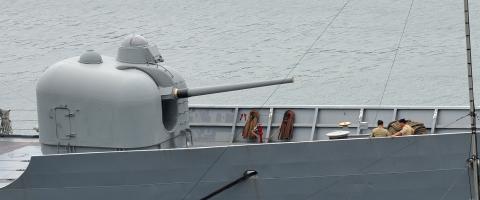|
MND report highlights
threat of PRC
GOLIATH: The report says the PLA’s budget
provides a 20-to-one dollar-for-dollar advantage over Taiwan’s and that it could
seize Taiwan’s outlying islands by 2020
By Rich Chang / Staff Reporter

Photo taken on July 19, 2011
shows a Knox-class frigate of Taiwanese navy anchors in the island’s northern
Keelung harbour. Taiwan’s defence ministry unveiled its 2011 national defence
report, warning that China’s military threat against Taiwan is bigger than ever.
Photo: AFP
The balance of power in the Taiwan Strait
is rapidly shifting in Beijing’s favor, the Ministry of National Defense said in
this year’s National Defense Report released yesterday, adding that China’s
People’s Liberation Army (PLA) could blockade Taiwan and seize its outlying
islands by 2020.
The report said the PLA aimed to be able to launch a full-scale military attack
against Taiwan by 2020 and it was developing the capabilities necessary to
prevent foreign forces from intervening on Taiwan’s behalf.
China plans to launch its first indigenous aircraft carrier in 2020 and to
deploy stealth fighters on it, the report said.
The PLA’s Beidou navigation satellite system, which will greatly enhance
precision-strike capabilities, is also scheduled for completion by 2020, it
said.
The report said “the gap in national defense budgets between both sides is
widening, with China’s military budget 21 times that of Taiwan’s, while China’s
military spending is now second only to the US globally.”
The report said China’s declared defense budget last year was US$77 billion,
dwarfing Taiwan’s US$9 billion military budget. However, the actual Chinese
military budget might have exceeded US$200 billion, which would provide Beijing
with a dollar-for-dollar advantage of more than 20-to-one, it said.
The report said that in the 20 years to 2009, China’s military spending had
maintained double-digit growth nearly every year, with total spending ranking
first in Asia, threatening other countries in the region.
China’s official military spending this year is budgeted at US$93 billion, the
report said, citing official Chinese statistics. The PLA has more than 2.3
million personnel, against 270,000 in Taiwan, or a -ratio of nine to one, it
said.
The report said China had deployed a small number of Dong-Feng 21D “carrier
killer” ballistic missiles last year, which could threaten aircraft carriers,
the main platform the US would likely use if it intervened in any future
conflict in the Taiwan Strait.
China has deployed more than 1,000 missiles along its southeastern coast
targeting Taiwan, while intensely building air defense and anti-ship bases along
the coast.
Advanced weapons systems are deployed in Fujian and Guangdong provinces, with an
emphasis on strengthening long-range force projection capabilities.
“This indicates that the Chinese communists have not altered their thinking of
[posing a] military threat and invasion,” it said.
Regarding the PLA Air Force, it said China’s new-generation combat aircraft are
deployed at bases in Fujian and Guangdong, which are equipped with long-range
air-defense systems.
Long-range anti-ship missiles are deployed on ships at bases in the southeast
and new-type missile boats are also operational there, the report said.
Chinese unmanned aerial vehicles and high-speed anti-radiation missiles are
capable of attacking Taiwan’s command-and-control bases, it said.
As the military imbalance between Taiwan and China continues to expand, Taiwan
is developing asymmetric warfare capabilities and strengthening its conventional
forces to meet the challenge, the report said.
Commenting on the report, Democratic Progressive Party (DPP) lawmakers said it
was evidence that cross-strait military imbalance had grown rapidly since
President Ma Ying-jeou (馬英九) took power in 2008.
Taiwan’s military spending has fallen well short of the 3 percent of GDP that Ma
had promised. The national defense budget this year accounts for just 2.2
percent of GDP, a five-year low.
A lack of funding and major new weapons purchases have undermined Taiwan’s
defensive capabilities, DPP Legislator Tsai Huang-liang (蔡煌瑯) said.
“Reducing our military manpower and the budget is an indirect surrender to
[China],” DPP Legislator Chen Ming-wen (陳明文) said.
ADDITIONAL REPORTING BY VINCENT Y. CHAO, AP AND AFP
|
![]()
![]()
![]()